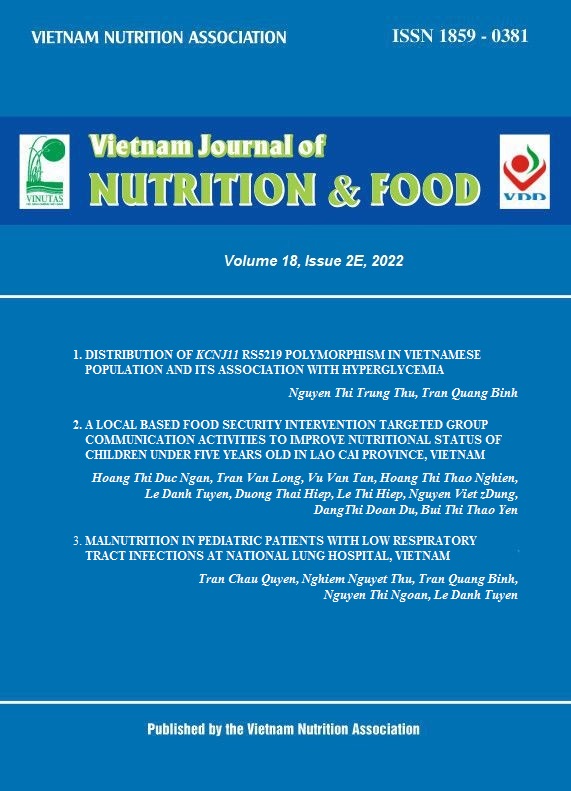A LOCAL BASED FOOD SECURITY INTERVENTION TARGETED GROUP COMMUNICATION ACTIVITIES TO IMPROVE NUTRITIONAL STATUS OF CHILDREN UNDER FIVE YEARS OLD IN LAO CAI PROVINCE, VIETNAM
Nội dung chính của bài viết
Tóm tắt
Aims: The study was conducted to (i) determine the effectiveness of the local-based food security intervention in improving the knowledge and practice of mothers in infant and young child feeding (IYCF) practices, and (ii) assess the effectiveness of the intervention in improving the nutritional status of children under five years in two communes in Lao Cai province.
Methods: The open community intervention was conducted from 2014 to 2016 on all children under five years old and their primary caregivers in Thao Chu Phin and Ban Pho commune, Lao Cai province. Care Group consisted of 10-12 mothers/primary caregivers, and Village Kitchen consisted of a group of women in the village, were established and met weekly to enhance rice powder production and peer communication activities in the communes. All 150 and 194 pairs of child-primary caregiver at baseline and the end of the intervention, respectively were assessed for children’s weight and height, and primary caregivers’ knowledge, attitude, and practices on IYCF.
Results: The prevalence of stunting significantly reduced at the conclusion of the intervention, from 59.3 to 43.5% in Ban Pho commune (p<0.01) and from 73.3% to 53.0% in Thao Chu Phin commune (p<0.001). Anthropometric indicators, except for weight, improved at the end of the study (all p<0.05). The proportion of primary caregivers who had correct knowledge about food diversity for complementary feeding significantly increased from 15.5% to 56.9% (p<0.001). More food was given to children for complementary feeding (all p<0.05).
Conclusions: The intervention of local-based food security and enhancing group communication was effective in improving the knowledge, attitude, and practice of primary caregivers on IYCF, anthropometric indicators, and in reducing childhood stunting.
Từ khóa
: food security, supplementary feeding, malnutrition, children, stunting
Chi tiết bài viết
Tài liệu tham khảo
2. Long TV, Phuong HN. Complementary feeding practices for children 6-23 months and assocaited factors in two communes Ban Pho and Thao Chu Phin, Lao Cai province in 2014. Journal of Practical Medicine. 2015; 971(7): 50-54.
3. Tuyen LD, Ngan HTD. Food security of households with children under two years old in Ban Pho and Thao Chu Phin commune in Lao Cai province. Journal of Food and Nutrition Science. 2016;12(2):3-9.
4. National Institute of Nutrition. Report on summary of 10 years implementing the Protein Energy Malnutrition Control and strategies for the period of 2010-2020. Protein Energy Malnutrition Control: Hanoi, Vietnam: 2010.
5. Macharia TN, Ochola S. Association between household food security and infant feeding practices in urban informal settlements in Nairobi, Kenya. Journal of Developmental Origins of Health and Disease. 2018; 9(1):20-29.
6. National Center for Health Statistics. NHANES: Anthropometry procedures manual. Revised. 2004
7. WHO. Indicators for assessing infant and young child feeding practices. Part 1 definitions. Washington DC: 2008
8. Zebsyn S, Akheruzzaman M. Nutrition education and homestead food production ensures household food security: an experimental study. Journal of Science and Technology. 2018; 8(1&2):89-96.
9. Sangra S and Nowreen N. Knowledge, attitude, and practice of mothers regarding nutrition of under-five children: a cross-sectional study in rural settings. International Journal of Medical Science and Public Health. 2019; 8(5):392-394.
10. Kuchenbecker J, Reinbott A. Nutrition education improves dietary diversity of children 6-23 months at community-level: Results from a cluster randomized controlled trial in Malawi. PLOS ONE. 2017; 12(4):e0175216.
11. Ali NB, Tahsina T. (2019). Association of food security and other socio-economic factors with dietary diversity and nutritional statuses of children aged 6-59 months in rural Bangladesh. PLOS ONE. 2019; 14(8): e0221929.


